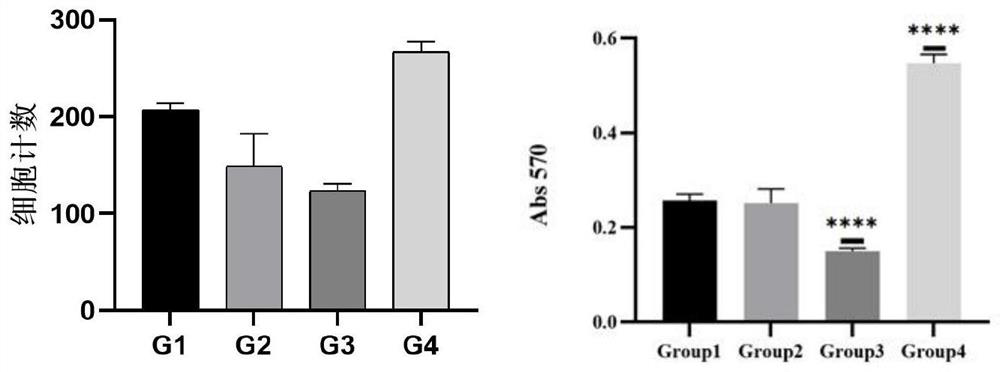Efficient and economical porcine muscle stem cell separation method and application thereof
A stem cell and muscle technology, applied in the biological field, can solve the problems of high cost of flow sorting instruments and follow-up maintenance costs, difficulty in popularization, and difficulty in industrialization, etc., achieves efficient and economical separation and extraction methods, less chance of contamination, and improves cell survival rate effect
- Summary
- Abstract
- Description
- Claims
- Application Information
AI Technical Summary
Problems solved by technology
Method used
Image
Examples
Embodiment 1
[0042] Example 1: Determination of pronase digestibility
[0043] All experiments were performed in a sterile environment (biosafety cabinet or ultra-clean bench), and the surgical instruments were all autoclaved.
[0044] (1) Obtain porcine muscle tissue
[0045] 3-day-old young pigs were selected, and CO was used 2 After being euthanized, the pigs were washed with sterile water and then soaked in 75% ethanol for 3 min. This was followed by two washes with sterile PBS buffer. Then, the pigs were aseptically dissected using autoclaved surgical instruments in a biological safety cabinet to remove the internal organs; then the back and leg muscles of the pigs were taken out with a scalpel and surgical scissors. The removed muscle tissue was washed twice with PBS buffer containing 1% penicillin-streptomycin-amphotericin B tertiary antibody (Antibiotic-Antimycotic, AA) and 1% gentamicin (GEN), and then stored in PBS containing 1%. %AA and 1% GEN in PBS buffer.
[0046](2) Cut...
Embodiment 2
[0064] Example 2 Determination of Final Enzyme Combination Digestion Mode
[0065] After the pronase was determined, the pronase was combined with trypsin, collagenase, and dispase into G4, G5, G6, and G7, respectively (see Table 1). Except for the G4 group, which required trypsin secondary digestion, the other three groups did not require secondary digestion. The remaining steps are the same as G1-G4. Specific steps are as follows:
[0066] (2) Cut muscle tissue
[0067] Put the preserved muscle tissue into a petri dish in a biological safety cabinet / clean bench, chop the muscle tissue with a scalpel, and remove fat, connective and other tissues during the process, and cut the muscle tissue in a short time as much as possible. Shred to 1mm 3 .
[0068] (3) Digestion to obtain a single cell population of muscle stem cells
[0069] First, 5 g of crushed muscle tissue was placed in 4 groups of 50 mL centrifuge tubes containing DMEM medium containing different digestive enz...
Embodiment 3
[0082] Example 3: Expression identification of Pax7 and MyoD in muscle stem cells of each group
[0083] For the cell suspension (G4-G7) obtained after differential purification in step (7) in Example 2, 5000 cells were taken and seeded in a 96-well plate, and Pax7 and MyoD were detected after the cells adhered for 48 hours. Another 10,000 cells were seeded in a 96-well plate, and the medium was complete medium, and the formula was as follows: DMEM medium containing 15% FBS, 10 ng / mL bFGF, 1% AA and 1% GEN.
[0084] 1) Fix with 50 μL of 4% paraformaldehyde (pre-cooling at 4°C), remove the paraformaldehyde after permeabilization at room temperature for 15 min, and carefully wash with PBS buffer 3 times;
[0085] 2) After adding 50 μL of 0.5% TritonX-100 for 15 min, remove the solution and carefully wash it three times with PBS buffer;
[0086] 3) Add blocking solution and incubate at room temperature for 30 min; remove the solution and carefully wash 3 times with PBS buffer; ...
PUM
 Login to View More
Login to View More Abstract
Description
Claims
Application Information
 Login to View More
Login to View More - R&D
- Intellectual Property
- Life Sciences
- Materials
- Tech Scout
- Unparalleled Data Quality
- Higher Quality Content
- 60% Fewer Hallucinations
Browse by: Latest US Patents, China's latest patents, Technical Efficacy Thesaurus, Application Domain, Technology Topic, Popular Technical Reports.
© 2025 PatSnap. All rights reserved.Legal|Privacy policy|Modern Slavery Act Transparency Statement|Sitemap|About US| Contact US: help@patsnap.com



